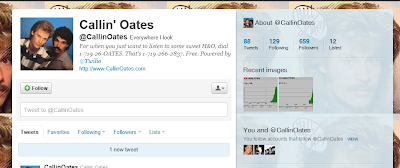CallinOates: The cloud development future in a nutshell


If you're on Twitter you've probably seen references to @callinoates, a dial-a-song service that's devoted to nothing but Hall And Oates songs (sadly not including my favourite, their cover of Mike Oldfield's Family Man). It quickly became a viral hit, but it's the tech behind that's rather fascinating, as it's powered by one of the more interesting cloud services around, Twilio.
Perhaps best thought of as a cloud telco, Twilio is designed to deliver telecoms services cheaply and effectively, with very simple API that makes it easy to quickly build SMS or voice services into a web application – or into any application, on any platform. Twilio applications don't even need to be fronted by a user interface, and like CallinOates, can be hooked up to automated voice and number recognition systems that let you use a phone to drive interactive services. Alternatively you can use Twilio to drive SMS services – something used by eBay and Airbnb.
Coding Twilio applications is easy, as it's based around RESTful APIs and XML data structures. You can quickly hook the various elements together and tie them into your own backend code. That's what CallinOates is, a relatively basic IVR application built by linking a simple audio player to cloud stored tracks with some PHP and a Dropbox account. And it wasn't developed by a pro developer either…
Mary and I visited Twilio's offices in San Francisco back in October, and one of the things we learnt was that every member of staff has to build an application using Twilio's tools in their first week. It turns out that CallinOates service had been built by a San Francisco PR contact of ours, Michael Selvidge, who'd put us in touch with many interesting startups over the last few years, and had recently joined Twilio. So while it's from a Twilio employee, it's from one who's definitely not a professional developer (even if he did get a friend to help with the code!).
Sure, it's a light hearted piece of fluff (and we can just about forgive the pun), but it shows just how easy it is to use a lot of the new generation of cloud services. Somewhere between Platform as a Service and the old model of plug-in components for Visual Basic, they're giant Lego bricks in the sky that can be plugged into an application. Call them API-as-a-Service if you will, they’re the evolution of the Web 2.0 mashups that were so popular a few years back – but now with business models of their own, and tooling that makes them a smart alternative to working directly with a traditional service provider.
Why do you need to contract with a telco to get SMS service when you can buy it cheaper from somewhere like Twilio, and at the same time get a simpler way of building into your applications? What was complex has become simple. It's an example of what CA's CTO Don Ferguson was talking about, when I spoke to him at CAWorld, talking about how cloud computing is going to kill programming (or rather, change enterprise application development completely). All you'll need to do is find what you need, subscribe to it, and configure it. That's exactly what Twilio offers developers – along with a backend that's proven to scale with the load that comes from powering the holiday season viral hit…
Not a bad bit of marketing after all.
And who doesn't like a little Hall and Oates?
Simon Bisson
